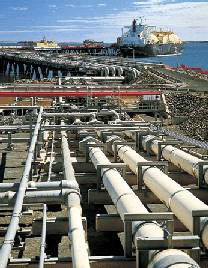Focus on LNG
For even more information on LNG, check out the Center for LNG.
Cooling natural gas to about -260°F at normal pressure results in the condensation of the gas into liquid form, known as Liquefied Natural Gas (LNG). LNG can be very useful, particularly for the transportation of natural gas, since LNG takes up about one six hundredth the volume of gaseous natural gas. While LNG is reasonably costly to produce, advances in technology are reducing the costs associated with the liquification and regasification of LNG. Because it is easy to transport, LNG can serve to make economical those stranded natural gas deposits for which the construction of pipelines is uneconomical.
 |
| LNG Delivery Facility with Tanker |
| Source: NGSA |
LNG, when vaporized to gaseous form, will only burn in concentrations of between 5 and 15 percent mixed with air. In addition, LNG, or any vapor associated with LNG, will not explode in an unconfined environment. Thus, in the unlikely event of an LNG spill, the natural gas has little chance of igniting an explosion. Liquification also has the advantage of removing oxygen, carbon dioxide, sulfur, and water from the natural gas, resulting in LNG that is almost pure methane.
LNG is typically transported by specialized tanker with insulated walls, and is kept in liquid form by autorefrigeration, a process in which the LNG is kept at its boiling point, so that any heat additions are countered by the energy lost from LNG vapor that is vented out of storage and used to power the vessel.
The use of LNG allows for the production and marketing of natural gas deposits that were previously economically unrecoverable. Imported LNG accounts for slightly more than 1 percent of natural gas used in the United States. According to the EIA, the U.S. imported 0.41 Tcf of natural gas in the form of LNG in 2010. However, due to increased domestic production, LNG imports are expected to decrease by an average annual rate of 4.1 percent, to levels of 0.14 Tcf of natural gas by 2035.
Liquefied natural gas (LNG) imports represent an important part of the natural gas supply picture in the United States. LNG takes up much less space than gaseous natural gas, allowing it to be shipped much more efficiently.
LNG that is imported to the United States comes via ocean tanker. The U.S. gets a majority of its LNG from Trinidad and Tobago, Qatar, and Algeria, and also receives shipments from Nigeria, Oman, Australia, Indonesia, and the United Arab Emirates.
For more information:
- The Center for LNG
- Federal Energy Regulatory Commission: LNG
- Interstate Natural Gas Association of America – LNG
- University of Houston: Commercial Frameworks for LNG in North America, Introduction to LNG
- Center for Energy Economics/UT-Austin: LNG Safety and Security
- Platts Guide to LNG
- LNG Safety Video
- U.S. LNG Markets and Uses
- LNG One World
- California Energy Commission: LNG
- International Liquefied Natural Gas Alliance
- Adventures in Energy